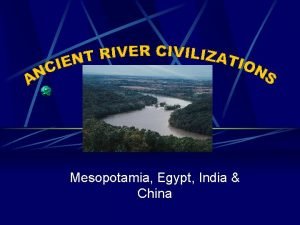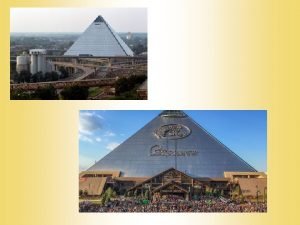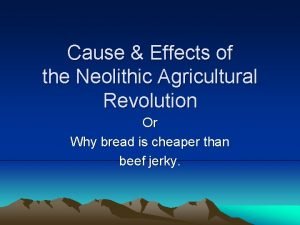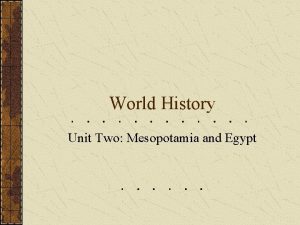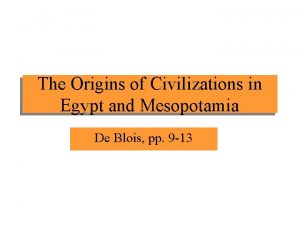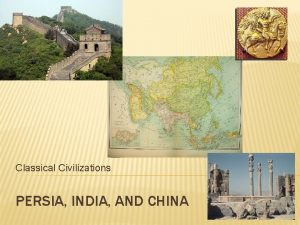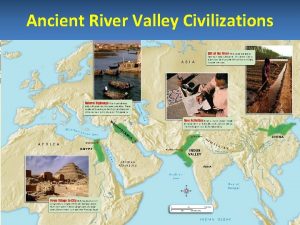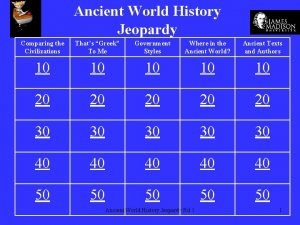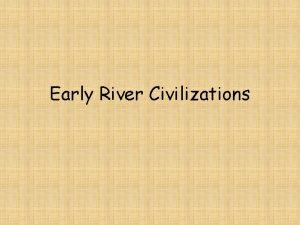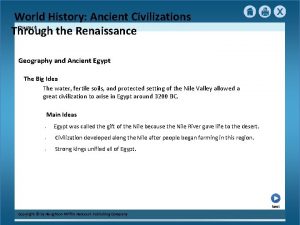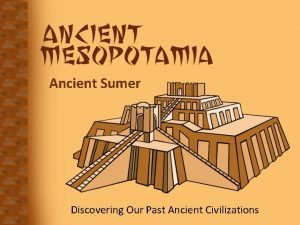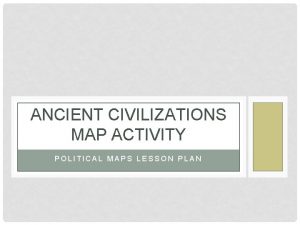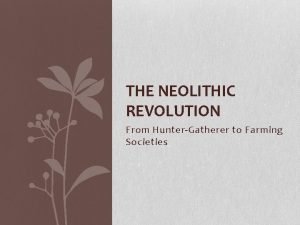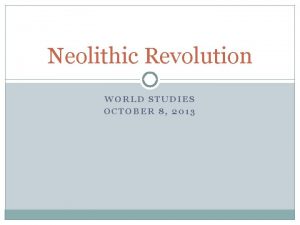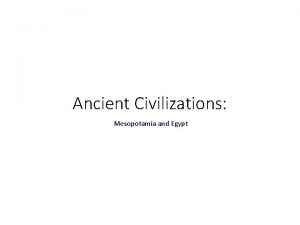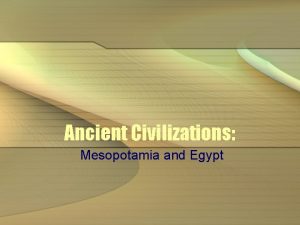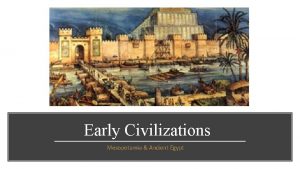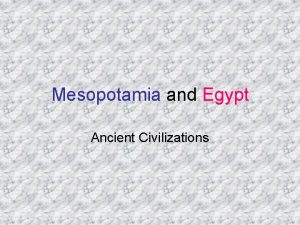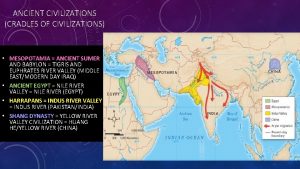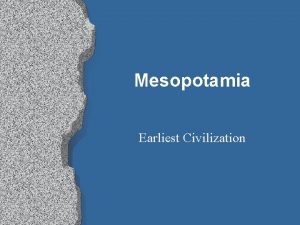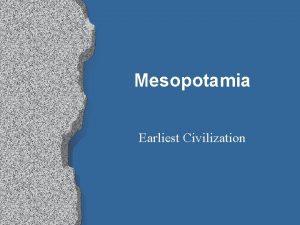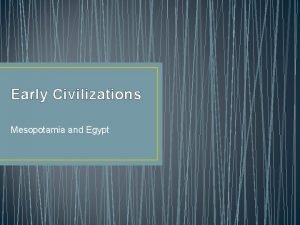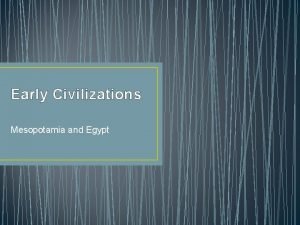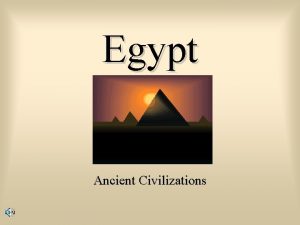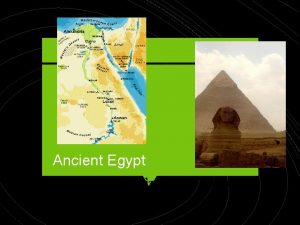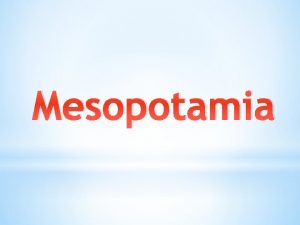Ancient Civilizations Mesopotamia and Egypt Neolithic Revolution Also


















- Slides: 18

Ancient Civilizations: Mesopotamia and Egypt

Neolithic Revolution • Also called the agricultural revolution • Was a major change in human life caused by the beginnings of farming. • People shifted from food gathering to food producing. • Food surplus due to agriculture is the most important factor in the development of civilization. • Artifacts-human-made objects such as tools and jewelry

Mesopotamia • The “land between the rivers” • Also known as the Fertile Crescent because the resource-rich land made agriculture and growth possible • Located between the Tigris and Euphrates Rivers

People of Mesopotamia • Sumerians • Organization • Independent city-states around 3500 BC • ruled by a king • often warred with each other • Sumerian Culture • Polytheism-belief in more than one god • Believed that many different gods controlled the various forces in nature

People of Mesopotamia • Sumerians cont. • Contributions • Cuneiform writing • Used a reed stylus on clay to make wedge shaped symbols • System of numbers based on 60 • We use this today with telling time • Architecture • Sumerians built pyramid like temples called Ziggurats

Babylonians • King Hammurabi Took over Sumer around 1900 BC became Babylonian Empire • Contributions: • Code of Hammurabi • One of the earliest written law codes • “Eye for an eye” punishment • Lower class/women punished more severely than upper class/ men (unequal) • Astronomy • Believed stars affected their lives BUT learned to predict eclipses and recognize planets • Religious literature • Epic of Gilgamesh: one of the earliest creation stories • Describes creation of man and woman and building an ark before a great flood

Egypt • Geography • 550 miles long, 15 miles on both sides of Nile • Nile floods once a year leaving rich soil • Early Government • Needed to control flooding and for irrigation • Build dams, reservoirs, and canals • Eventually formed two kingdoms • Upper and Lower Egypt • 3100 BC Menes united the two • He was first Pharaoh

Egyptian Life • Absolute Monarchy/ Theocracy • Pharaoh was a living god • Made laws, built canals and public buildings, set taxes, • Assisted by nobles and priests in a bureaucracy • Class System • Nobles, Priests • Lower classes • Peasants and slaves • Could not participate in government • Religion • Polytheistic • Preserved bodies with mummification • Pharaohs in Pyramids

Contributions of Egypt • Architecture and Engineering • Pyramids, temples with columns • Art • Cheerful and colorful frescoes, huge statues, gold jewelry, pottery • Hieroglyphic writing • Began as pictographs • First “paper” called papyrus • Translated with Rosetta stone which has Hieroglyphic and Greek writing on it • Science • 365 day year • Set bones, prescribed drugs, understood much about the body because of mummification

Phoenicians • 1200 BC – Centered north of Palestine • Skilled shipbuilders and navigators • Traded throughout Mediterranean and to Europe and Africa • Contributions • “Missionaries of Civilization” • Brought Mediterranean culture and products to less advanced regions • Traded Purple Dye made from crushed snail shells • Alphabet • Based on sound with 22 letters; Phonetic Alphabet • Eventually becomes the alphabet we use

Hebrews • History • 1400 BC – Settled in Palestine • Exiled to Babylon (later allowed back to Palestine) • Moses led them out of slavery in Egypt (10 Commandments) • Contributions • Monotheism • Old Testament • High moral principles • Ten Commandments • Covenant of Abraham • “father” of Judaism • Made a covenant (agreement) with God • Worship no other God • They were the chosen people

Polytheism v. Monotheism • What is the difference between monotheism and polytheism? • Use evidence from your notes

China • Huang He • Yellow River Valley (northern China) • Called this because of the loess (silt) that turns the water “yellow” • Early agriculture (millet and rice) • Early dynasties will form here • Shang, Zhou, Qin, Han, etc…

Early India – 2500 BCE • Modern day parts of Pakistan and India • Little known about this civilization • Language never decoded • Organized into complex city-states • Mohenjo-Daro • Harappa

Bantu Migrations

Bantu Migrations • Long complex process where two groups of Bantu speakers eventually linked up • Bantu based languages began to dominate the continent • This can still be seen today • The Bantu people brought new agricultural practices to mostly nomadic peoples

Modern Language family map of Africa • What language family has the most land? • What is important about the Niger River?

The Olmec – 1200 BCE • First known Mesoamerican civilization • Along the Gulf Coast allowed the Olmec to thrive. • • Resources: Salt, tar, wood and rubber Created large heads that represent rulers Trade network from Mexico City to Honduras Decline - Not fully understood • Outside invasion or self destruction
 Map of mesopotamia egypt india and china
Map of mesopotamia egypt india and china Upper egypt and lower egypt
Upper egypt and lower egypt Cause and effect of agricultural revolution
Cause and effect of agricultural revolution Site:slidetodoc.com
Site:slidetodoc.com Egypt vs mesopotamia
Egypt vs mesopotamia River valley civilizations map
River valley civilizations map Lesson 1 early civilizations
Lesson 1 early civilizations The two classical civilizations of ancient india were the
The two classical civilizations of ancient india were the Civilization ppt template
Civilization ppt template Ap world jeopardy
Ap world jeopardy Ancient civilizations of the old world map
Ancient civilizations of the old world map World history ancient civilizations through the renaissance
World history ancient civilizations through the renaissance Discovering our past ancient civilizations
Discovering our past ancient civilizations Ancient civilizations map activity
Ancient civilizations map activity Join the neolithic revolution cartoon
Join the neolithic revolution cartoon Neolithic revolution
Neolithic revolution The rise of civilization lesson 2 the neolithic revolution
The rise of civilization lesson 2 the neolithic revolution Before neolithic
Before neolithic Whats neolithic revolution
Whats neolithic revolution
